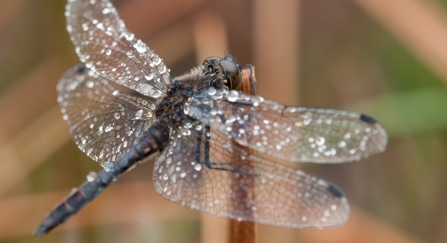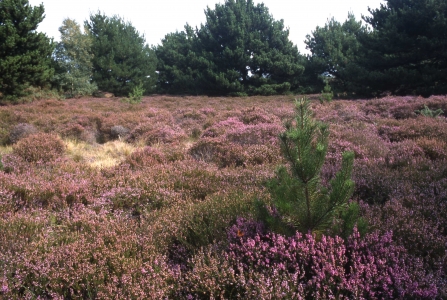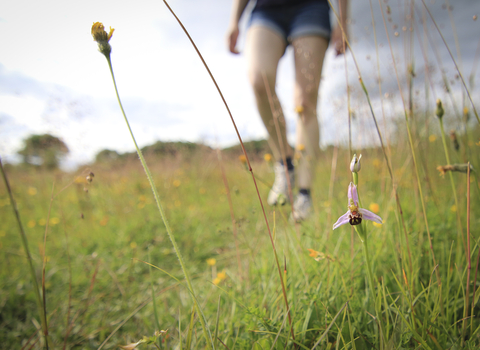From post-industrial sites being reclaimed by nature to wide-open wetlands busy with piping wading birds, there are so many places to enjoy Wild Walk Week outings across Lancashire, Manchester and North Merseyside.
Wild Walk Week – Where to get your steps in

Brockholes, Preston
With three trails to choose from, Brockholes Nature Reserve in Preston is perfect for everyone from free-range families to seasoned ramblers. Choose from:
- The Reserve Trail – two miles (around 4,250 steps)
- The Meadow Trail – 1.5 miles (around 3,500 steps)
- The Gravel Pit Trail – a quarter of a mile (around 1,500 steps)
And don’t forget the wildlife-spotting opportunities as you walk. As a former quarry, Brockholes is a haven of colourful wildflowers and lakes brimming with bird and insect life, and boasts a peaceful patch of ancient woodland where tawny owls roost and roe deer roam.

Mere Sands Wood by Phil Smith
Mere Sands Wood, Ormskirk
Mere Sands Wood in Ormskirk has a number of tranquil footpaths taking in its lakes, woodland and wildflower meadows. The longest is around 1.8 miles, which equates to around 3,000 steps and a whole lot of contentment. We challenge you to take a walk here and not leave feeling completely at peace.

Salthill Quarry, Clitheroe
Beautiful footpaths, gorgeous views of Pendle Hill, and fossils – what’s not to love? Salthill Quarry is a hidden gem in Clitheroe: a fabulous place to see orchids, spot butterflies and see fossils called ‘crinoids’. Crinoids are fossilised sea lilies and are evidence of Salthill Quarry’s past life at the bottom of the ocean! The best way to explore Salthill Quarry is the Geology Trail, a circular walk that takes in the best spots on the reserve.

Whitethroat by Jon Hawkins - Surrey Hills Photography
Heysham Nature Reserve, Morecambe
What better place to tot up some Wild Walk Week steps than by the glittering sea? Heysham Nature Reserve is nestled right on the coast and is one of the best places in our region to spot birds. Meadow pipits, sedge warblers, whitethroats, chiffchaffs, greenfinches, linnets, grasshopper warblers: the list goes on! The reserve is also right by Half Moon Bay and not far from our Heysham Moss reserve, so there are plenty of options to extend your walk.

Morecambe Bay from the top of Warton Crag
Warton Crag, Carnforth
If you’re craving a walk that’s a bit more challenging then you can’t go wrong with Warton Crag. The terrain is rough and uneven, and the paths rise steeply up the limestone cliffs, but you’ll be rewarded ten-fold with breath-taking views over Morecambe Bay.
Where to walk in Greater Manchester

Kingfisher by Jon Hawkins - Surrey Hills Photography
The Kingfisher Trail, Lancashire and Greater Manchester
Fancy testing your endurance? The Kingfisher Trail is a scenic 14-mile walk connecting the rural West Pennine Moors to the urban communities of Bolton, Bury and Salford. It’s a wonderful show of our region’s diversity and a great opportunity to revel in a bit of local history. The whole trail equates to around 17,500 steps and is a great route for those eager to see – you guessed it – a kingfisher!
One of the many pools at Wigan Flashes
Wigan Flashes, Wigan
Wigan Flashes is a stunning mosaic of open water, reedbed, fen, rough grassland, wet woodland and scrub with plenty of footpaths to explore during Wild Walk Week. What’s more, it joins up with other important nature reserves such as Abram Flash SSSI and Hope Carr Nature Reserve to form a 9km wetland retreat along the Leeds-Liverpool Canal – perfect for getting your steps in.
Moss Bank Park, Bolton
A fantastic, family-friendly place to stretch your legs, Moss Bank Park in Bolton is a wide-open parkland with fields, gardens and play areas to keep everyone occupied while you raise your step count for Wild Walk Week. Don’t forget to stop by The Café to refuel with a range of takeaway sandwiches, soups and snacks.

Black darter dragonflies rely on peat bogs, moors and acidic pools for their survival. Image by Vaughn Matthews
Little Woolden Moss, Irlam
After years of continuing restoration work by our peatlands team, Little Woolden Moss is transforming into a wonderful example of a lowland peatland habitat. A footpath runs through the reserve, linking it with the larger Great Bog Hop Trail, and offers a stunning glimpse of life in these unique habitats. Keep your eyes peeled for dragonflies and birds of prey as you walk!
Where to walk in North Merseyside

Lunt Meadows, Merseyside
A three-mile loop around Lunt Meadows in Maghull will help you rack up around 5,500 steps, and there is so much to see along the way. Water voles scamper along the watery channels beside the footpath, dragonflies hawk over the water and countless bird species feed and breed on the wetland. Keep your eyes peeled for avocets, lapwings and redshank - you may even be lucky enough to spot a marsh harrier soaring over the reeds.

Freshfield Dune Heath is an internationally rare habitat and would be lost without conservation grazing. Image by Alan Wright
Freshfield Dune Heath, Merseyside
What could encapsulate Wild Walk Week better than a wander through one of the rarest habitats in North West England? The 1.5-mile loop at Freshfield Dune Heath in Formby will add around 3,500 extra steps to your count, but the best part will be experiencing a truly special wild place that your fundraising efforts will help to protect.
We hope this has provided some inspiration for your week of wild walks, but if you still aren’t sure where to get your steps in, search for a nature reserve near you.





